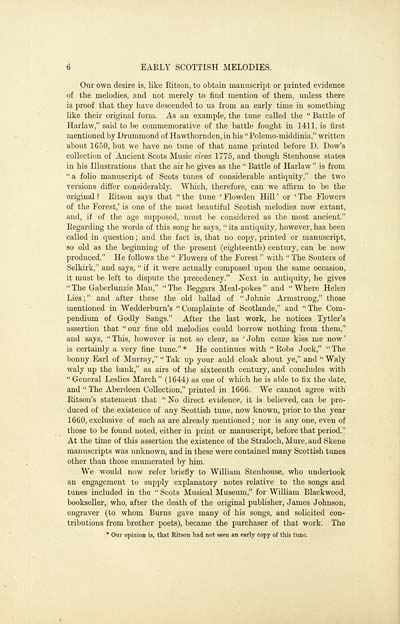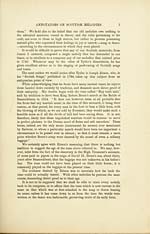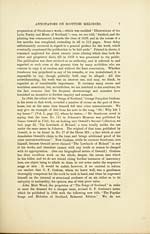Inglis Collection of printed music > Printed text > Early Scottish melodies
(28) Page 6
Download files
Complete book:
Individual page:
Thumbnail gallery: Grid view | List view

6 EARLY SCOTTISH MELODIES.
Our own desire is, like Ritson, to obtain manuscript or printed evidence
of the melodies, and not merely to find mention of them, unless there
is proof that they have descended to us from an early time in something
like their original form. As an example, the tune called the " Battle of
Harlaw," said to be commemorative of the battle fought hi 1411, is first
mentioned by Drummond of Hawthornden, in his " Polemo-middinia," written
about 1650, but we have no tune of that name printed before D. Dow's
collection of Ancient Scots Music circa 1775, and though Stenhouse states
in his Illustrations that the air he gives as the " Battle of Harlaw " is from
" a folio manuscript of Scots tunes of considerable antiquity," the two
versions differ considerably. Which, therefore, can we affirm to be the
original ? Ritson says that " the tune ' Flowden Hill ' or ' The Flowers
of the Forest,' is one of the most beautiful Scotish melodies now extant,
and, if of the age supposed, must be considered as the most ancient."
Regarding the words of this song he says, " its antiquity, however, has been
called in question ; and the fact is, that no copy, printed or manuscript,
so old as the beginning of the present (eighteenth) century, can be now
produced." He follows the " Flowers of the Forest " with " The Souters of
Selkirk," and says, " if it were actually composed upon the same occasion,
it must be left to dispute the precedency." Next in antiquity, he gives
" The Gaberlunzie Man," " The Beggars Meal-pokes " and " Where Helen
Lies ; " and after these the old ballad of " Johnie Armstrong," those
mentioned in Wedderburn's " Complainte of Scotlande," and " The Com-
pendium of Godly Sangs." After the last work, he notices Tytler's
assertion that " our fine old melodies could borrow nothing from them,"
and says, " This, however is not so clear, as ' John come kiss me now '
is certainly a very fine tune." * He continues with " Robs Jock," " The
bonny Earl of Murray," " Tak up your auld cloak about ye," and " Waly
waly up the bank," as airs of the sixteenth century, and concludes with
" General Leslies March " (1644) as one of which he is able to fix the date,
and " The Aberdeen Collection," printed in 1666. We cannot agree with
Ritson's statement that " No direct evidence, it is believed, can be pro-
duced of the existence of any Scottish tune, now known, prior to the year
1660, exclusive of such as are already mentioned; nor is any one, even of
those to be found noted, either in print or manuscript, before that period."
At the time of this assertion the existence of the Straloch, Mure, and Skene
manuscripts was unknown, and in these were contained many Scottish tunes
other than those enumerated by him.
We would now refer briefly to William Stenhouse, who undertook
an engagement to supply explanatory notes relative to the songs and
tunes included in the " Scots Musical Museum," for William Blackwood,
bookseller, who, after the death of the original publisher, James Johnson,
engraver (to whom Burns gave many of his songs, and solicited con-
tributions from brother poets), became the purchaser of that work. The
* Our opinion is, that Ritson had not seen an early copy of this tune.
Our own desire is, like Ritson, to obtain manuscript or printed evidence
of the melodies, and not merely to find mention of them, unless there
is proof that they have descended to us from an early time in something
like their original form. As an example, the tune called the " Battle of
Harlaw," said to be commemorative of the battle fought hi 1411, is first
mentioned by Drummond of Hawthornden, in his " Polemo-middinia," written
about 1650, but we have no tune of that name printed before D. Dow's
collection of Ancient Scots Music circa 1775, and though Stenhouse states
in his Illustrations that the air he gives as the " Battle of Harlaw " is from
" a folio manuscript of Scots tunes of considerable antiquity," the two
versions differ considerably. Which, therefore, can we affirm to be the
original ? Ritson says that " the tune ' Flowden Hill ' or ' The Flowers
of the Forest,' is one of the most beautiful Scotish melodies now extant,
and, if of the age supposed, must be considered as the most ancient."
Regarding the words of this song he says, " its antiquity, however, has been
called in question ; and the fact is, that no copy, printed or manuscript,
so old as the beginning of the present (eighteenth) century, can be now
produced." He follows the " Flowers of the Forest " with " The Souters of
Selkirk," and says, " if it were actually composed upon the same occasion,
it must be left to dispute the precedency." Next in antiquity, he gives
" The Gaberlunzie Man," " The Beggars Meal-pokes " and " Where Helen
Lies ; " and after these the old ballad of " Johnie Armstrong," those
mentioned in Wedderburn's " Complainte of Scotlande," and " The Com-
pendium of Godly Sangs." After the last work, he notices Tytler's
assertion that " our fine old melodies could borrow nothing from them,"
and says, " This, however is not so clear, as ' John come kiss me now '
is certainly a very fine tune." * He continues with " Robs Jock," " The
bonny Earl of Murray," " Tak up your auld cloak about ye," and " Waly
waly up the bank," as airs of the sixteenth century, and concludes with
" General Leslies March " (1644) as one of which he is able to fix the date,
and " The Aberdeen Collection," printed in 1666. We cannot agree with
Ritson's statement that " No direct evidence, it is believed, can be pro-
duced of the existence of any Scottish tune, now known, prior to the year
1660, exclusive of such as are already mentioned; nor is any one, even of
those to be found noted, either in print or manuscript, before that period."
At the time of this assertion the existence of the Straloch, Mure, and Skene
manuscripts was unknown, and in these were contained many Scottish tunes
other than those enumerated by him.
We would now refer briefly to William Stenhouse, who undertook
an engagement to supply explanatory notes relative to the songs and
tunes included in the " Scots Musical Museum," for William Blackwood,
bookseller, who, after the death of the original publisher, James Johnson,
engraver (to whom Burns gave many of his songs, and solicited con-
tributions from brother poets), became the purchaser of that work. The
* Our opinion is, that Ritson had not seen an early copy of this tune.
Set display mode to: Large image | Transcription
Images and transcriptions on this page, including medium image downloads, may be used under the Creative Commons Attribution 4.0 International Licence unless otherwise stated. ![]()
| Special collections of printed music > Inglis Collection of printed music > Printed text > Early Scottish melodies > (28) Page 6 |
|---|
| Permanent URL | https://digital.nls.uk/94643608 |
|---|
| Description | Scottish and English songs, military music and keyboard music of the 18th and 19th centuries. These items are from the collection of Alexander Wood Inglis of Glencorse (1854 to 1929). Also includes a few manuscripts, some treatises and other books on the subject. |
|---|
| Description | The Glen Collection and the Inglis Collection represent mainly 18th and 19th century Scottish music, including Scottish songs. The collections of Berlioz and Verdi collected by bibliographer Cecil Hopkinson contain contemporary and later editions of the works of the two composers Berlioz and Verdi. |
|---|

